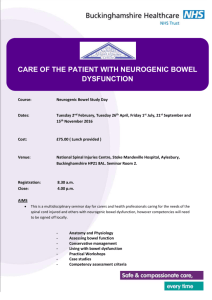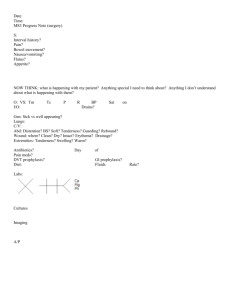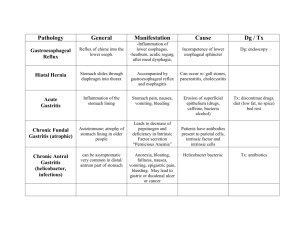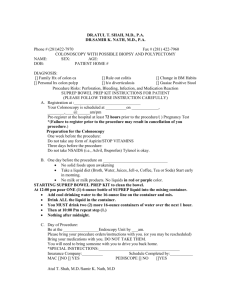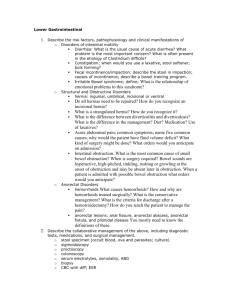Gastrointestinal Disease
advertisement
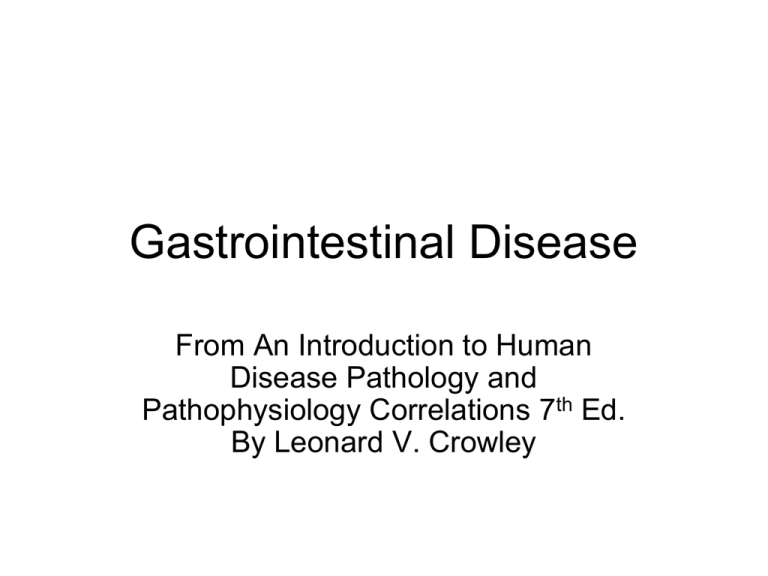
Gastrointestinal Disease From An Introduction to Human Disease Pathology and Pathophysiology Correlations 7th Ed. By Leonard V. Crowley Types of Diseases Included in the Gastrointestinal System • Cleft lip and Cleft Palate • Teeth Abnormalities • Neoplasia of the oral cavity • Gastritis • Stomach Carcinoma • Inflammatory Disease of the Intestine • Appendicitis • Bowel Disturbances • Diverticulitis and Diverticulosis • Intestinal Obstruction • Tumors of the Bowel • Hemorrhoids Anatomy of the GI Tract • • • • • • • Mouth (lips, face, tongue, teeth) Esophagus Stomach Small intestine Colon Anus Rectum Cleft lip and Cleft Palate • These are defects of the upper lip and jaw (cleft lip) or the area between the nose and mouth or palate (cleft plate). • Such abnormalities occur in 1 in 1000 births with high incidence in families with at least one child with either abnormality. • Treatment comes in the form of surgery. Speech therapy is recommended in early childhood. Teeth Abnormalities • Missing teeth or extra teeth • Loss of tooth enamel caused by antibiotic use especially tetracycline • Caries or tooth decay caused by dental plaque • Periodontal disease (gingivitis and pyorrhea) • Stomatitis (etiology: Candida albicans, alcohol, hot or spicy foods, etc…) What is the recommended hygiene to reduce dental caries? Neoplasia of the Oral Cavity • Carcinomas which are found in squamous epithelium of the cheek, tongue, lips, palate, or throat are considered oral cavity neoplasias. Diseases of the Esophagus Patients with esophageal disease experience problems associated with swallowing and episodes of choking. Mucosa in the esophagus can be destroyed or inflamed because of reflux esophagiatis. Cardiospasm may result when the cardiac sphincter fails to allow passage of food into the stomach. The esophagus becomes dilated because of food retention. Esophageal Disease Cont… Common complications associated with the esophagus include: Failure of the lower cardiac sphincter to correctly function Rips and tears of the lining associated with emesis Esophageal obstructions which arise from carcinoma, food blockages, or stricture (scarring) Gastritis • Acute or chronic inflammation of the stomach is called gastritis. The symptoms are pain and nausea. • Acute gastritis is usually self limiting and is associated with drugs like aspirin, ibuprofen, and other pain relievers. These nonsteroidal anti-inflammatory drugs may inhibit the production of prostaglandins that help protect the gastric mucosa which leads to gastritis and ulceration. Excessive alcohol consumption may also cause acute gastritis. • Chronic gastritis is largely associated with the organism Helicobacter pylori which colonize the gastric mucosa. The gastric acid is neutralized by ammonia produced by the organism. Chronic gastritis increases may lead to gastric carcinoma and malignant lymphoma. Peptic Ulcer • A peptic ulcer is a chronic ulcer of the distal area of the stomach or the proximal end of the duodenum. It is associated with Helicobacter pylori colonization that destroys the mucosa. The mucosa is perforated and gastric acid and pepsin digest deeper tissue. Scarring occurs at the base of the ulcer. Complications of the condition include: hemorrhage, perforation of associated organs, and obstruction. Antacids for ulcers are recommended. Surgery may also be required. Stomach Carcinoma • The initial symptoms for this disease mimic symptoms of a benign peptic ulcer. Many times the disease is discovered too late for successful treatment. To differentiate stomach carcinoma from other maladies, the physician may use gastroscopy and biopsy. Surgical resection of the affected areas is recommended. Inflammatory Disease of the Intestine • Enteritis is the inflammation of any area of the intestinal tract. • Colitis is inflammation of the colon. • Acute enteritis is usually caused by pathogenic organisms. Symptoms for this disease are vomiting, nausea, discomfort, diarrhea, and bloody stool. • Chronic enteritis is associated with two major conditions that are autoimmune diseases. These are Crohn’s Disease and chronic ulcerative colitis. Appendicitis • The appendix is a narrow vestigial structure from the colon. It may become impacted with fecal material and inflamed. Signs and symptoms of an acute appendicitis attack include: right lower quadrant abdominal pain, abdominal rigidity, and increased neutrophils in the peripheral circulation. Peritonitis may result which complicates the patient’s chances for recovery. Bowel Disturbances These disturbances include: lactose and gluten intolerances causing flatulence and loose stools. Irritable bowel syndrome of unknown etiology is a disease with disturbed bowel function, abdominal discomfort, and loud bowel gurgling. Diverticulitis and Diverticulosis • Outpouchings of the muscular wall of the large intestine are called diverticulosis. • Diverticula are observed in older patients with low residue that cause damaging hard stools. • Diverticula that become inflamed are called diverticulitis. Diverticulitis may progress to abscesses and ulceration. The condition may become serious and require surgical resection. Intestinal Obstruction • Intestines, that are blocked, are considered to have intestinal obstructions. Causes of intestinal obstruction include: 1. intestinal adhesions of connective tissue or loops of twisted bowel, 2. hernias or loops of bowel pushed through intestine into areas of the scrotum (inguinal hernia) or umbilical areas, 3. tumors, 4. volvulus or twisting of bowel to constrict blood supply and pulling the bowel from the wall of the abdomen. 5. intussusceptions, in children is usually a telescoping of the ileum into the colon through the ileocecal valve Tumors of the Bowel • Benign tumors of the colon called polyps do not usually cause symptoms and can be removed surgically with a colonoscope. • Carcinomas or the colon may block the colon and cause bowel obstruction symptoms. These tumors may bleed and lead to chronic iron-deficiency anemia Hemorrhoids • The condition in which swollen veins of the venous plexus drain into the rectum and anus is called a hemorrhoid. Hemorrhoids are caused by constipation and straining during bowel movements. They may also appear during pregnancies. Hemorrhoids may become thrombosed and cause discomfort. Surgical removal of hemorrhoids may be recommended.



